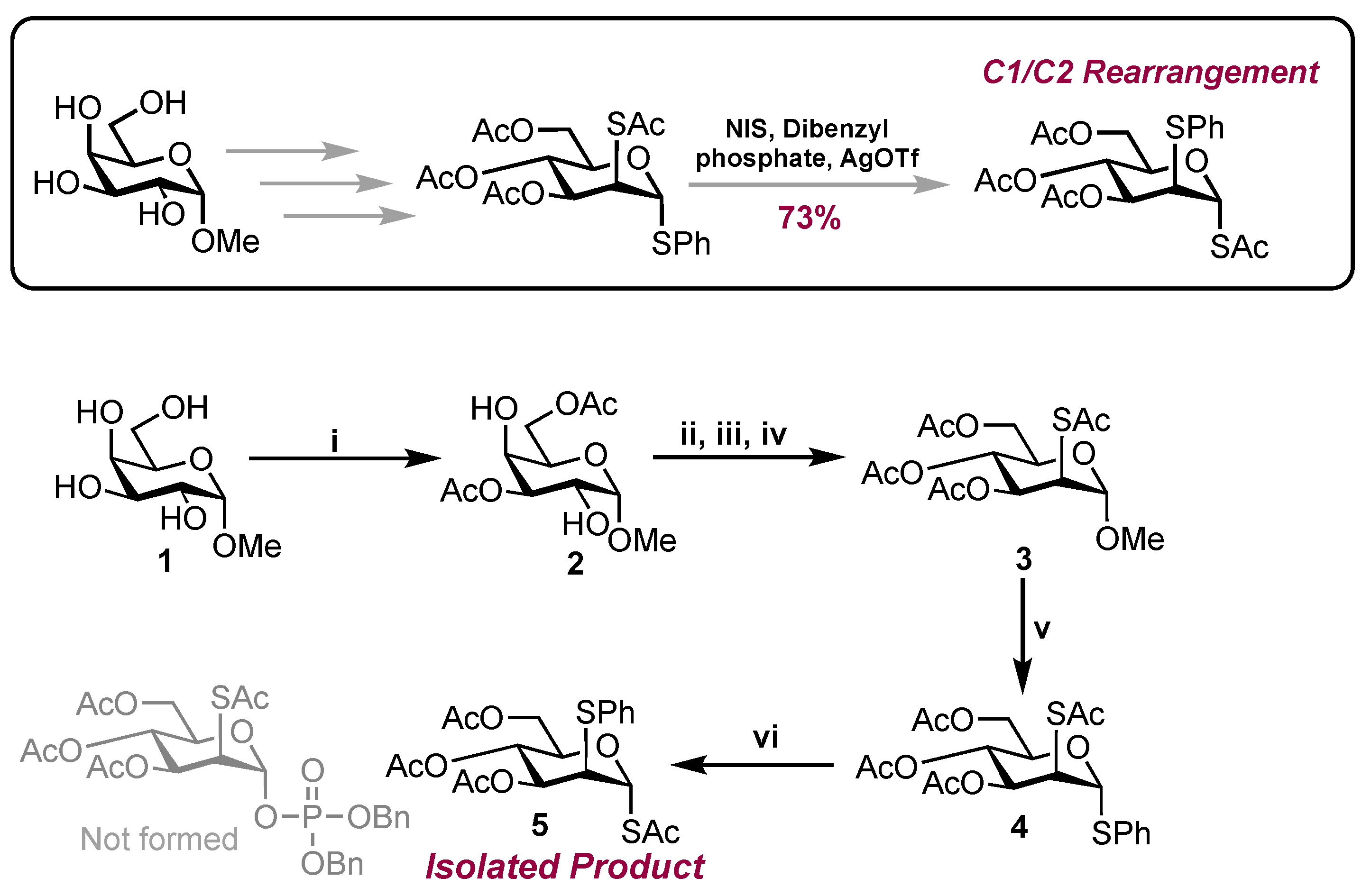3,4,6-Tri-O-acetyl-1-S-acetyl-2-deoxy-2-S-phenylthio-α-d-mannopyranoside
Abstract
1. Introduction
2. Results
3. Materials and Methods
3.1. General
3.2. Methyl 3,6-Di-O-acetyl-α-d-galactopyranoside (2)
3.3. Methyl 3,4,6-Tri-O-acetyl-2-S-acetyl-2-thio-α-d-mannopyranoside (3)
3.4. Phenyl 3,4,6-Tri-O-acetyl-2-deoxy-2-S-acetyl-1,2-di-thio-α-d-mannopyranoside (4)
3.5. Acetyl 3,4,6-Tri-O-acetyl-2-deoxy-2-S-phenyl-1,2-di-thio-α-d-mannopyranoside (5)
Supplementary Materials
Author Contributions
Funding
Data Availability Statement
Acknowledgments
Conflicts of Interest
References
- Romanò, C.; Jiang, H.; Boos, I.; Clausen, M.H. S-Glycosides: Synthesis of S-Linked Arabinoxylan Oligosaccharides. Org. Biomol. Chem. 2020, 18, 2696–2701. [Google Scholar] [CrossRef] [PubMed]
- He, P.; Zhang, X.; Xia, K.; Green, D.E.; Baytas, S.; Xu, Y.; Pham, T.; Liu, J.; Zhang, F.; Almond, A.; et al. Chemoenzymatic Synthesis of Sulfur-Linked Sugar Polymers as Heparanase Inhibitors. Nat. Commun. 2022, 13, 7438. [Google Scholar] [CrossRef] [PubMed]
- Keenan, T.; Hatton, N.E.; Porter, J.; Vendeville, J.B.; Wheatley, D.E.; Ghirardello, M.; Wahart, A.J.C.; Ahmadipour, S.; Walton, J.; Galan, M.C.; et al. Reverse Thiophosphorylase Activity of a Glycoside Phosphorylase in the Synthesis of an Unnatural Manβ1,4GlcNAc Library. Chem. Sci. 2023, 14, 11638–11646. [Google Scholar] [CrossRef] [PubMed]
- Dada, L.; Colomer, J.P.; Manzano, V.E.; Varela, O. Synthesis of Thiodisaccharides Related to 4-Thiolactose. Specific Structural Modifications Increase the Inhibitory Activity against E. Coli β-Galactosidase. Org. Biomol. Chem. 2023, 21, 2188–2203. [Google Scholar] [CrossRef] [PubMed]
- Driguez, H. Thiooligosaccharides as Tools for Structural Biology. ChemBioChem 2001, 2, 311–318. [Google Scholar] [CrossRef] [PubMed]
- Montero, E.; García-Herrero, A.; Asensio, J.L.; Hirai, K.; Ogawa, S.; Santoyo-González, F.; Cañada, F.J.; Jiménez-Barbero, J. The Conformational Behaviour of Non-Hydrolizable Lactose Analogues: The Thioglycoside, Carbaglycoside, and Carba-Iminoglycoside Cases. Eur. J. Org. Chem. 2000, 2000, 1945–1952. [Google Scholar] [CrossRef]
- Wilson, J.C.; Kiefel, M.J.; Angus, D.I.; Itzstein, M. von Investigation of the Stability of Thiosialosides toward Hydrolysis by Sialidases Using NMR Spectroscopy. Org. Lett. 1999, 1, 443–446. [Google Scholar] [CrossRef] [PubMed]
- Porter, J.; Parisi, D.; Miller, T.; Ní Cheallaigh, A.; Miller, G.J. Chemical synthesis of amphiphilic glycoconjugates: Access to amino, fluorinated and sulfhydryl oleyl glucosides. Carbohydr. Res. 2023, 530, 108854. [Google Scholar] [CrossRef] [PubMed]
- Porter, J.; Lima, M.A.; Pongener, I.; Miller, G.J. Synthesis of 4-Thio-D-Glucopyranose and Interconversion to 4-Thio-D-Glucofuranose. Carbohydr. Res. 2023, 524, 108759. [Google Scholar] [CrossRef] [PubMed]
- O’Shea, C.; Miller, G.J. Synthesis of S-Glycoside Building Blocks as Mimetics of the Repeating d-GlcN-α-1,4-d-GlcA Heparan Sulfate Disaccharide. Molecules 2024, 29, 5809. [Google Scholar] [CrossRef] [PubMed]
- Ren, B.; Gan, L.; Zhang, L.; Yan, N.; Dong, H. Diisopropylethylamine-Triggered, Highly Efficient, Self-Catalyzed Regioselective Acylation of Carbohydrates and Diols. Org. Biomol. Chem. 2018, 16, 5591–5597. [Google Scholar] [CrossRef] [PubMed]
- Knapp, S.; Malolanarasimhan, K. Oligomeric Thioglycosides with α-D-Manno-(1′→2) Linkages from a Glycal-1,2-Episulfide. Org. Lett. 1999, 1, 611–613. [Google Scholar] [CrossRef]
- Wu, B.; Ge, J.; Ren, B.; Pei, Z.; Dong, H. Synthesis and Binding Affinity Analysis of Positional Thiol Analogs of Mannopyranose for the Elucidation of Sulfur in Different Position. Tetrahedron 2015, 71, 4023–4030. [Google Scholar] [CrossRef]


Disclaimer/Publisher’s Note: The statements, opinions and data contained in all publications are solely those of the individual author(s) and contributor(s) and not of MDPI and/or the editor(s). MDPI and/or the editor(s) disclaim responsibility for any injury to people or property resulting from any ideas, methods, instructions or products referred to in the content. |
© 2025 by the authors. Licensee MDPI, Basel, Switzerland. This article is an open access article distributed under the terms and conditions of the Creative Commons Attribution (CC BY) license (https://creativecommons.org/licenses/by/4.0/).
Share and Cite
Porter, J.; Miller, G.J. 3,4,6-Tri-O-acetyl-1-S-acetyl-2-deoxy-2-S-phenylthio-α-d-mannopyranoside. Molbank 2025, 2025, M1981. https://doi.org/10.3390/M1981
Porter J, Miller GJ. 3,4,6-Tri-O-acetyl-1-S-acetyl-2-deoxy-2-S-phenylthio-α-d-mannopyranoside. Molbank. 2025; 2025(1):M1981. https://doi.org/10.3390/M1981
Chicago/Turabian StylePorter, Jack, and Gavin J. Miller. 2025. "3,4,6-Tri-O-acetyl-1-S-acetyl-2-deoxy-2-S-phenylthio-α-d-mannopyranoside" Molbank 2025, no. 1: M1981. https://doi.org/10.3390/M1981
APA StylePorter, J., & Miller, G. J. (2025). 3,4,6-Tri-O-acetyl-1-S-acetyl-2-deoxy-2-S-phenylthio-α-d-mannopyranoside. Molbank, 2025(1), M1981. https://doi.org/10.3390/M1981





